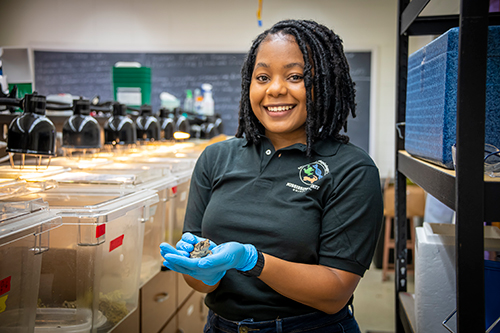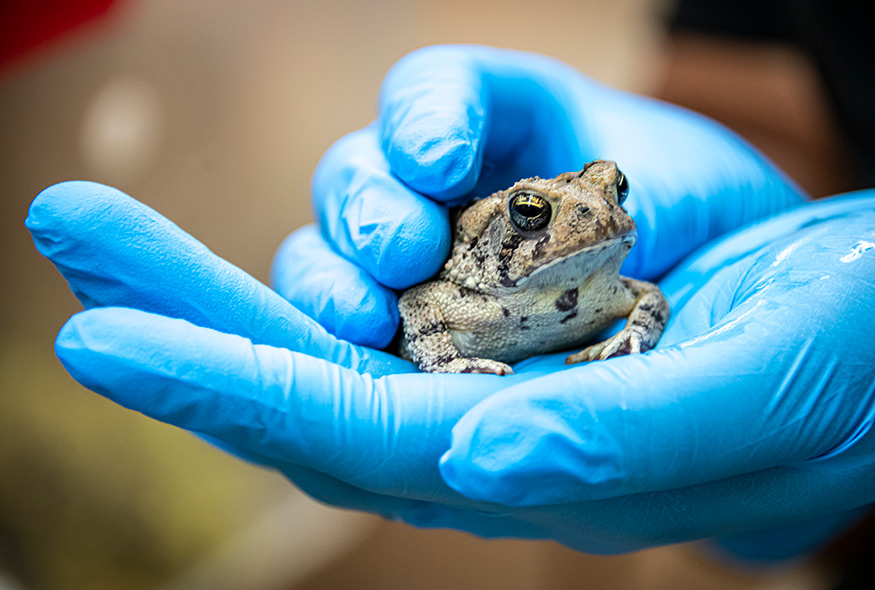Contact: Meg Henderson
STARKVILLE, Miss.—Polar bears. Giant pandas. Mountain gorillas. In the last several decades, these endangered animals have attracted attention—deservedly so—but what about the smaller, less conspicuous amphibians that are on the brink of extinction? Mississippi State researchers are focused on saving them, too.
Scientists in the MSU Forest and Wildlife Research Center and the Mississippi Agricultural and Forestry Experiment Station are leading a consortium of partners to advance the establishment and implementation of a National Amphibian Genome Bank. The NAGB, located on MSU’s campus, is a repository of cryopreserved germplasm—for example, sperm and eggs—from amphibians, including frogs, toads, salamanders and newts.
The NAGB is a distinct type of biobank or frozen zoo. As the name implies, a cryobank allows for the deposit and withdrawal of sperm, eggs or embryos to sustainably produce new animals for collections management, reintroductions and to conduct research.

The Institute of Museum and Library Services awarded the MSU-led team a National Leadership Grant of $749,000 to support the collection’s care and management of reproductive materials from high-priority amphibian species. The grant also supports research on cryopreservation of reproductive cells, training for students and zoo staff in biomaterial banking, and connective captive and wild animal genetic management through a “One Plan Approach” to conservation.
The One Plan Approach was established by the Conservation Planning Specialist Group, member of the International Union for Conservation of Nature, to develop management strategies and conservation actions for all populations of a species, whether inside or outside their natural range.
Project Director Carrie Vance, associate professor in MSU’s Department of Biochemistry, Molecular Biology, Entomology and Plant Pathology, and co-principal investigator Andy Kouba, head of MSU’s Department of Wildlife, Fisheries and Aquaculture, established the NAGB about 15 years ago, in collaboration with Scott Willard, dean of the university’s College of Agriculture and Life Sciences and MAFES director.
With more than 40% of amphibians threatened with extinction, Vance and Kouba began their journey more than 20 years ago to find solutions to preserve the amphibian genomic tree of life and ensure no U.S. species would be forever lost.
The new grant establishes MSU as the NAGB hub with three zoo partner satellite centers in the Southeast, Southwest and Midwest, allowing the team to work on a continental scale and target more than 30 different species in danger of extinction. Other principal partners include the Fort Worth Zoo, North Carolina Zoo, Omaha’s Henry Doorly Zoo, U.S. Fish and Wildlife Service, the Association of Zoos and Aquariums, state wildlife agencies and private landowners.
“This award from IMLS will not only safeguard against extinction and help manage our living collections, but the biobank will preserve amphibian ecological and biological information and may advance science in ways we don’t anticipate,” said Kouba.
Dustin Smith, curator at the North Carolina Zoo, added, “The biobank and the associated reproductive technologies give us more tools in our toolbox for conserving threatened amphibians.”

When a species becomes threatened or endangered, zoos and aquariums often set up captive breeding programs with the goal of releasing individuals back into the wild as part of their recovery efforts.
“A lot of these captive breeding efforts are challenging because they can’t replicate the environmental cues that stimulate reproduction,” said Vance. “Hormone and in-vitro fertilization protocols circumvent this lack of natural breeding.”
The genome bank stores over 1,500 frozen specimens in liquid nitrogen tanks that maintain a temperature of -1960C. Digital metadata contains information on each specimen’s species, sex, location and other characteristics. When a zoo needs a particular genetic line, MSU can ship the cryopreserved sperm, which is then thawed to fertilize a female’s eggs.
Diane Barber, curator at the Fort Worth Zoo, said, “The partnerships between the university and zoos have expanded the role both types of institutions can play in training the next generation of scientists who will be challenged with sustaining the populations of critically endangered species.”
Additional outputs of the project include a suite of resources and educational products to assist zoo staff in implementing hormone therapy, ultrasound, sperm and egg analysis, in-vitro fertilization and sperm cryopreservation.
“Over the last century, we have lost over 100 amphibian species, with hundreds more on the brink,” said Kouba. “Extinction is forever, and we will never see the likes of these lost species on our planet again. But we have the tools to ensure a zero-extinction future scenario.”
For more information about the project, visit the NAGB at the conservation physiology website https://conservationphys.msstate.edu/amphibian-grb.php.
Mississippi State University is taking care of what matters. Learn more at www.msstate.edu.